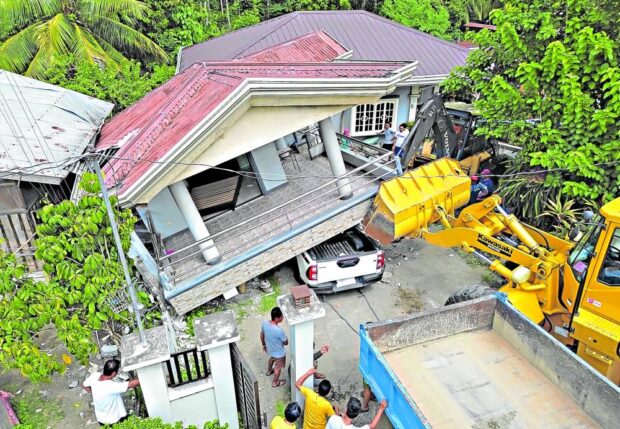
AFTERMATH | A bulldozer lifts a portion of the collapsed balcony of a house in Malapatan town, Sarangani province, while a truck pulls a vehicle pinned underneath that debris. (Photo by ERWIN M. MASCARIÑAS / Inquirer Mindanao)
GLAN, Sarangani, Philippines — Dionil Cabeje, 50, spent his Sunday morning trying to salvage what remained of his family’s house that was wrecked by strong tremors on Friday afternoon when a magnitude 6.8 earthquake cut a deadly path of destruction across Mindanao.
Several other houses in his neighborhood of Logpan, a coastal community in Barangay Poblacion here, were also damaged.
“The earthquake was so strong that it only took a few moments for it to totally destroy my house. The violent shaking was too much for my small shanty,” Cabeje said.
Amid the screaming, he remembered rushing his family outside into a clearing, where they stood in shock as the intense shaking brought their house down.
“We had difficulty standing upright as we [fled],” Cabeje recalled.
After the shaking subsided, Cabeje said they noticed the sea had receded by about 10 meters, only to return as a big wave that crashed into houses and fishing boats.
Fisherman Renante Galarce, 49, said he and nine others lost a boat to the strong surge of seawater.
“While we watched several of the houses collapse and get destroyed, the worst part for a fisherman like me was seeing our boats destroyed by the waves that came after,” Galarce lamented.
Some smaller boats had been cut in half, but even large boats were not spared.
‘Horrible sight’
“Boats that take five to six men to carry just went upside down, tumbling through the waterline against the sands; it was a horrible sight,” Galarce said.
In the wake of the strong waves, several boats were piled high on top of one another. Some boats slammed into the stilts of houses, knocking them down.
Mayor Victor James Yap Sr. said about 30 meters of the extension area of the municipal fish port had been destroyed as well.
He said some motorbike riders and passengers were slightly injured when they fell to the ground as the tremor peaked.
The mayor said he had been officiating a wedding in one of the town’s beach resorts when he first noticed “an up-and-down movement, then it shook from side to side, making it impossible to stand up.”
Jessa, who owns a small variety store, had the same experience.
Her merchandise fell to the ground while she was taking cover under a table. She recalled that when she tried to run, “I could not stand because the movement of the ground was so strong.”
“That is why I just screamed for help until the shaking stopped,” Jessa said.
Ruben Naraga recalled how he and others stumbled as they ran for safety. “I even rolled on the ground,” he said.
Fear of tsunami
But what frightened them the most was the possibility of a tsunami, Naraga said.
Most people in the neighborhood sought shelter among friends and relatives in Barangay Calabanit, a village in an elevated part of town.
“We prioritized the old, our women and children, while most men came back to guard their belongings and boat engines from thieves who might take advantage of the situation,” Cabeje said.
The families only returned on Saturday afternoon, relieved by the assurances of government seismologists that no tsunami was forthcoming.
But they were disturbed again on Sunday morning when a magnitude 4.3 aftershock struck Glan.
According to the Philippine Institute of Volcanology and Seismology (Phivolcs), Friday’s tremor off Sarangani Island in Davao Occidental was felt at intensity 7 in Glan.
It is the highest on the scale of intensities and is classified as destructive. At this intensity, a localized tsunami is possible, according to Phivolcs.
The death toll, as of Sunday, reached eight, disaster officials said.
A total of 16 schools sustained infrastructure damage due to the Mindanao quake, based on the latest data from the Department of Education.
The agency said the cost of infrastructure damage amounted to around P111 million, while the non-infrastructure damage in computers, furniture, and learning resources stood at about P29.4 million.
The Department of Human Settlements and Urban Development said on Sunday it activated its shelter cluster teams in quake-affected regions in Mindanao.
All regional directors were ordered to closely monitor their areas and “facilitate emergency responses and humanitarian assistance as needed.”